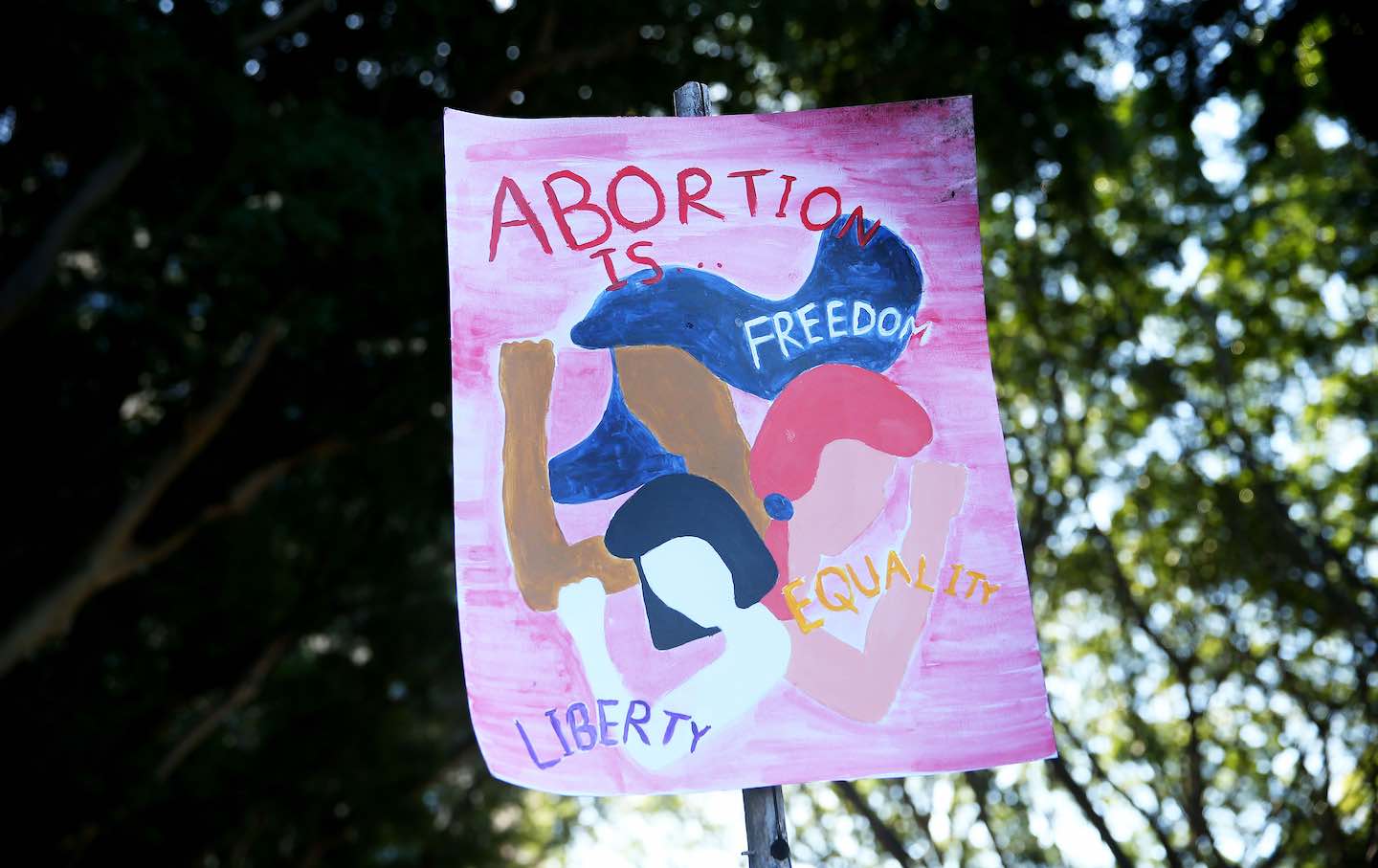
Signage can be seen at Hyde Park on June 9, 2019, in Sydney, Australia. The march was organized by a Sydney high school student in response to Alabama’s new abortion law in the United States. (Photo by Don Arnold / Getty Images)
As the midterms inch closer, Democratic candidates and organizations are finally in sync on messaging about reproductive rights in the wake of the Dobbs ruling overturning abortion rights protections. Many groups finally place abortion in the context of freedom because, as we saw in primaries nationwide, it is a winning issue. Voters understand that if they can’t control when and if they want to parent and are forced to endure a pregnancy they don’t want or are not ready for, they are not completely free.
Access to abortion is about bodily autonomy. But on the 46th anniversary of the Hyde Amendment, a budget rider that prohibits federal funds from covering abortion care for Medicaid beneficiaries, pro-choice candidates would do well to remember that abortion access is also about economic justice.
Democratic and Republican consultants—mainly white men—typically frame abortion as a “social issue,” like LGBTQ+ rights or racial justice: the subtext being that it’s an issue that gets in the way of talking about the “real” issues voters care more about, like the economy. At a time when the pandemic has contributed to rising food and gas prices, the economy is a priority for many voters. But to dismiss abortion as an issue not at all related to the economy is to overlook the kitchen-table economics affecting everyday decisions about when and if to start or grow a family.
Have you seen outside? To quote many from Black Twitter: “Outside is expensive.” And it’s not just because of inflation; many things were expensive even before the pandemic jacked up prices, like child care. In 2022, nearly 60 percent of families plan to spend more than $10,000 on child care—more than the average annual cost of in-state college tuition. Some day cares cost $1,300 per month, but others can cost as much as $3,000 per child! So combine these considerations with the increased cost of groceries, housing, and exorbitant student loan debt—at the same time that wages haven’t kept up with the cost of living—and then is it all that surprising that the birthrate is low right now?
And if you are a working-class or lower-income family, federal funding for child care is not enough, due to funding shortages. A family may be eligible but not receive assistance, or may not qualify because of impossible standards. In 13 states, a family of three with an annual income above $32,580 would not qualify for assistance.
This is why the Hyde Amendment is particularly cruel. Since September 30, 1976, when the House first passed the restriction on federal Medicaid funding for abortion, the amendment has harmed the lowest-income Americans, many of whom are people of color. Indeed, that was Representative Henry Hyde’s intention. As he is often quoted as saying during the floor debate, “I would certainly like to prevent, if I could legally, anybody having an abortion, a rich woman, a middle class woman, or a poor woman. Unfortunately, the only vehicle available is the HEW Medicaid bill.”
Of course, anti-abortion lawmakers didn’t stop there. Today, there are also bans that withhold abortion coverage from millions of people who receive health care insurance through federal programs, such as federal workers, military personnel, imprisoned or detained people, and Native Americans. It is because of the Hyde Amendment that abortion funds came into existence to help people fund their abortions and the expenses that can come with traveling out of state for care. But abortion funds can’t possibly keep up with the need—and they shouldn’t have to.
When people are considering having a child or continuing a pregnancy, not being able to afford the expenses associated with raising a child is one of the top reasons they consider delaying or not having a child, the Guttmacher Institute has found. Six in 10 women who have abortions are already mothers, and half of them have two or more children, according to 2019 data from the Centers for Disease Control and Prevention. Therefore, they already know the cost of having another child, and want to focus on providing for the ones they have.
Although Democrats have been doing well when discussing abortion as an issue of freedom, they must also discuss it as the economic issue that it is. This provides a clear opening for Democrats to highlight their successes under Biden and their legislative priorities if they retain power in Congress. Democrats must also make it clear to voters that the Republican Party, with very rare exceptions, has been about the business of weakening the social safety net. The GOP halted progress on Biden’s Build Back Better Act despite the fact that parts of that legislation, such as additional funding for child care and paid family leave, were popular with their base. Fifty-seven percent of polled GOP voters supported additional funding to states to make child care more affordable, while nearly 60 percent of Republican women backed paid family leave, even when it was framed as a Democratic proposal.
There is a lot on the line this fall. If Democrats want to build on their majority, not only at the federal level but also the state and local level, talking about abortion and access to contraception as matters of economic justice will resonate with people, especially in these times.
Atima OmaraAtima Omara is the founder and principal strategist for Omara Strategy Group—a consulting firm working at the intersection of politics and the progressive movement with candidates and organizations that center women, people of color, and other underrepresented communities in their work. Atima has worked as staff and consultant for Democratic federal, state, and local political campaigns in Virginia and across the country, as well as for multiple progressive, labor, and community organizations.